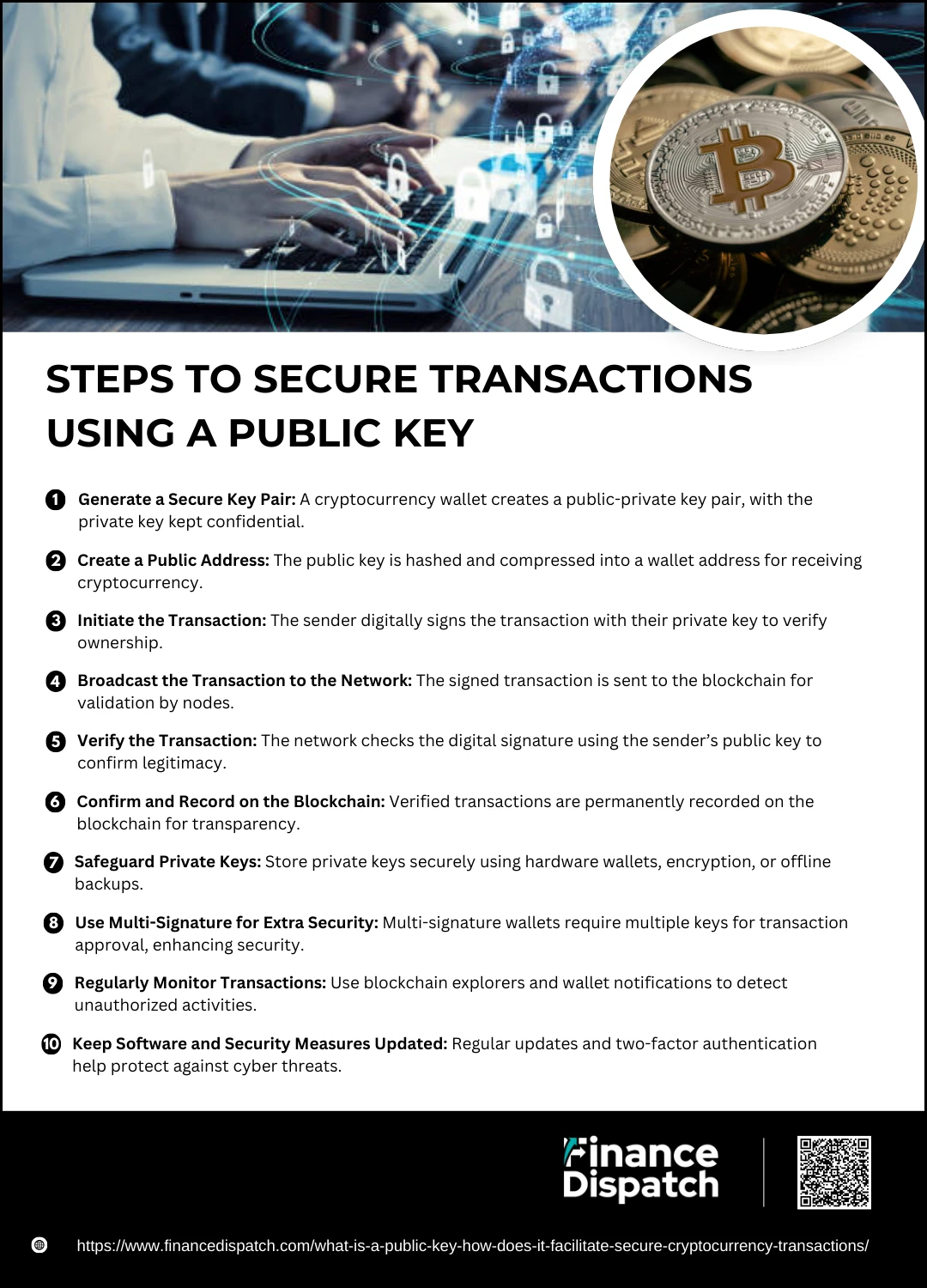In the world of cryptocurrency, security is paramount. Public key cryptography plays a crucial role in ensuring that transactions remain safe, transparent, and tamper-proof. A public key is an essential part of asymmetric encryption, where it works alongside a private key to authenticate and secure digital transactions. This system allows users to send and receive cryptocurrencies without exposing sensitive information, ensuring that only the rightful owner can access their funds. By verifying digital signatures and generating unique wallet addresses, public keys facilitate seamless transactions on blockchain networks like Bitcoin and Ethereum. In this article, we’ll explore what a public key is, how it is created, and the critical role it plays in securing cryptocurrency transactions.
What is a Public Key?
A public key is a cryptographic code used in asymmetric encryption, allowing secure communication and transactions over digital networks. It is mathematically derived from a private key and serves as a digital identifier that can be openly shared without compromising security. In cryptocurrency transactions, a public key is used to generate a public address, enabling users to receive funds securely. While anyone can see and use the public key for verification, only the corresponding private key holder can authorize transactions. This encryption mechanism ensures that digital assets remain protected from unauthorized access, making public keys a fundamental component of blockchain security.
How Public Key Works in Cryptography
Public key cryptography, also known as asymmetric encryption, is a secure method of encrypting and authenticating data using a pair of keys—a public key and a private key. Unlike symmetric encryption, where the same key is used for both encryption and decryption, public key cryptography ensures that encrypted data can only be decrypted by the corresponding private key. This makes it ideal for secure communications, digital signatures, and cryptocurrency transactions. Public key cryptography plays a vital role in securing online interactions, preventing unauthorized access, and ensuring the authenticity of digital messages and transactions.
 How Public Key Works: Key Processes
How Public Key Works: Key Processes
- Key Pair Generation: A cryptographic algorithm, such as RSA (Rivest-Shamir-Adleman) or ECC (Elliptic Curve Cryptography), generates a pair of mathematically linked keys—one public and one private.
- Encryption Process: A sender encrypts a message or data using the recipient’s public key. This ensures that only the recipient, who possesses the corresponding private key, can decrypt the message.
- Decryption Process: When the encrypted message reaches the recipient, their private key is used to decrypt and access the original information securely.
- Digital Signatures for Authentication: A sender can sign a document or transaction with their private key, and the recipient (or anyone else) can verify its authenticity using the sender’s public key. This ensures data integrity and prevents tampering.
- Blockchain and Cryptocurrency Transactions: In blockchain networks like Bitcoin and Ethereum, public keys are used to generate wallet addresses, enabling users to receive cryptocurrency securely. Transactions are verified using public keys without revealing the corresponding private keys.
- Public Key Infrastructure (PKI): PKI is a framework that manages public and private key authentication, ensuring secure communication over the internet through digital certificates and SSL/TLS encryption for websites.
How a Public Key Facilitates Cryptocurrency Transactions
Public key cryptography plays a fundamental role in securing cryptocurrency transactions by ensuring that funds are transferred safely while maintaining transparency and decentralization. In this system, every user has a public key and a private key, forming a unique cryptographic pair. The public key allows users to receive cryptocurrency and verify transactions, while the private key remains secret and is used to authorize transactions. This setup ensures that only the rightful owner of the private key can spend the associated funds. Since cryptocurrency transactions occur on a decentralized blockchain, public keys provide a trustless security mechanism where transactions are validated without requiring third-party intermediaries like banks.
 How Public Keys Facilitate Cryptocurrency Transactions:
How Public Keys Facilitate Cryptocurrency Transactions:
1. Key Pair Generation
Every cryptocurrency wallet automatically generates a unique public-private key pair using cryptographic algorithms such as Elliptic Curve Cryptography (ECC).
2. Creating a Public Address
The public key is hashed and compressed into a public address (e.g., Bitcoin or Ethereum wallet address). This address is shared with others to receive funds securely.
3. Transaction Initiation
When a user wants to send cryptocurrency, they sign the transaction with their private key, proving ownership and authorization without exposing the key.
4. Transaction Verification
Once the transaction is broadcast to the blockchain, miners or validators use the public key to verify the digital signature and ensure the transaction is legitimate.
5. Recording on the Blockchain
After successful verification, the transaction is permanently recorded on the blockchain ledger, making it immutable and resistant to fraud.
6. Ensuring Security & Privacy
The public key system ensures that transactions remain transparent while keeping private keys hidden. Even though transactions are visible on the blockchain, only the rightful owner can access their funds.
7. Multi-Signature & Smart Contracts
Public keys also enable multi-signature wallets (requiring multiple keys to authorize transactions) and smart contracts, which automate secure transactions on blockchains like Ethereum.
Steps to Secure Transactions Using a Public Key
Public key cryptography provides a secure and efficient way to conduct cryptocurrency transactions, ensuring that funds are transferred safely while preventing fraud and unauthorized access. By leveraging a public-private key pair, users can send and receive digital assets with a high level of encryption and authentication. However, to maintain security, it’s crucial to follow specific steps when using public keys in transactions. Proper key management and best practices help safeguard digital wallets, prevent hacking attempts, and ensure the integrity of blockchain transactions.
 Steps to Secure Transactions Using a Public Key:
Steps to Secure Transactions Using a Public Key:
1. Generate a Secure Key Pair
A cryptocurrency wallet automatically generates a public and private key pair using cryptographic algorithms like Elliptic Curve Cryptography (ECC). The private key must always remain confidential, while the public key is used to derive a wallet address for receiving funds.
2. Create a Public Address
Since public keys are long and complex, they are hashed and compressed to create a shorter and more readable wallet address. This address is what users share when receiving cryptocurrency, ensuring funds are linked to the correct recipient.
3. Initiate the Transaction
When sending cryptocurrency, the sender must digitally sign the transaction using their private key. This process verifies ownership of the funds without exposing sensitive information.
4. Broadcast the Transaction to the Network
The signed transaction is transmitted to the blockchain network, where nodes (miners or validators) receive and validate it using the public key associated with the sender’s address.
5. Verify the Transaction
The network checks the digital signature using the sender’s public key to confirm that the transaction was genuinely authorized by the rightful owner. If the verification fails, the transaction is rejected.
6. Confirm and Record on the Blockchain
After successful verification, the transaction is permanently added to the blockchain ledger, ensuring transparency and immutability. Once recorded, the transaction cannot be altered, protecting against fraud.
7. Safeguard Private Keys
Since losing the private key means losing access to cryptocurrency funds, it is crucial to store it securely. Best practices include using a hardware wallet, an encrypted software wallet, or writing it down and keeping it in a safe place.
8. Use Multi-Signature for Extra Security
Multi-signature (multi-sig) wallets require multiple private keys to approve a transaction, reducing the risk of unauthorized transfers and enhancing security, especially for businesses or high-value crypto holdings.
9. Regularly Monitor Transactions
Using blockchain explorers and wallet notifications to track transactions helps users detect suspicious activity, unauthorized transactions, or potential hacking attempts.
10. Keep Software and Security Measures Updated
Regularly updating wallet software, enabling two-factor authentication (2FA), and using anti-malware protection ensures that security vulnerabilities are minimized, protecting against cyber threats and unauthorized access.
Public Key vs Private Key: Key Differences
Public and private keys are the foundation of asymmetric cryptography, ensuring secure digital communications, encrypted data transfer, and cryptocurrency transactions. These two keys work together but serve distinct roles: a public key is shared openly and used for encryption and verification, while a private key remains confidential and is required for decryption and authorization. In cryptocurrency, the public key helps generate a wallet address for receiving funds, whereas the private key is used to sign and approve transactions. Understanding the differences between these keys is essential for maintaining security and preventing unauthorized access.
Key Differences Between Public and Private Keys
| Feature | Public Key | Private Key |
| Visibility | Shared openly and accessible to anyone. | Kept secret and known only to the owner. |
| Usage | Encrypts data and verifies digital signatures. | Decrypts data and creates digital signatures. |
| Security Impact | Safe to share; cannot be used to steal funds. | Must be kept private; if exposed, funds or data can be compromised. |
| Role in Encryption | Used to encrypt messages and transactions. | Used to decrypt messages and verify authenticity. |
| Role in Digital Signatures | Verifies that a digital signature is valid. | Signs digital transactions and messages to prove ownership. |
| Application in Cryptocurrencies | Generates a wallet address for receiving funds. | Authorizes transactions and access to funds. |
| Risk if Lost | Can be regenerated from the private key. | If lost, access to associated funds or data is permanently lost. |
| Mathematical Relationship | Derived from the private key using cryptographic algorithms. | Created first and used to generate the public key. |
| Example Use Cases | Blockchain addresses, email encryption, SSL certificates. | Cryptocurrency transactions, password management, digital identity authentication. |
Debunking Common Myths about Public Keys
Public key cryptography plays a vital role in securing digital transactions, yet many misconceptions exist about how public keys work. Some people mistakenly believe that public keys can be used to steal funds, while others assume they are the same as wallet addresses. Understanding the truth behind these myths is essential for ensuring safe and secure transactions in cryptocurrency and online communications. Let’s debunk some of the most common myths surrounding public keys.
Common Myths about Public Keys
1. Myth: Public Keys Can Be Used to Steal Cryptocurrency
Reality: Public keys are used to receive funds and verify transactions, but they cannot be used to access or withdraw cryptocurrency. Only the corresponding private key can authorize transactions.
2. Myth: Public Keys and Wallet Addresses Are the Same
Reality: While public keys are used to generate wallet addresses, they are not identical. A wallet address is a hashed and shortened version of the public key, making it easier to use while maintaining security.
3. Myth: If Someone Knows Your Public Key, They Can Hack Your Private Key
Reality: Public keys are mathematically derived from private keys, but reversing this process is computationally impossible due to strong encryption algorithms like Elliptic Curve Cryptography (ECC) and RSA.
4. Myth: You Can Recover a Lost Private Key Using the Public Key
Reality: Public keys can be regenerated from private keys, but the reverse is not possible. Losing a private key means permanent loss of access to associated cryptocurrency or encrypted data.
5. Myth: Public Keys Need to Be Kept Secret
Reality: Public keys are meant to be shared openly to allow transactions and message encryption. Only private keys need to be kept secret.
6. Myth: All Public Keys Work the Same Way Across Cryptocurrencies
Reality: Different blockchains use public keys differently. Bitcoin, Ethereum, and other cryptocurrencies apply different hashing methods and address formats when creating wallet addresses from public keys.
7. Myth: Public Keys Expire Over Time
Reality: Public keys do not have an expiration date. They remain valid as long as their associated private key is secure and functional.
Conclusion
Public key cryptography is a cornerstone of digital security, enabling secure transactions, encrypted communications, and trustless interactions in decentralized systems like blockchain. While public keys are openly shared to facilitate transactions and verify digital signatures, private keys must remain confidential to prevent unauthorized access. Understanding how public keys work, their role in cryptocurrency transactions, and the myths surrounding them is essential for ensuring security in the digital world. By following best practices, such as safeguarding private keys, using multi-signature wallets, and staying informed about cryptographic advancements, users can confidently engage in secure and transparent online transactions.



